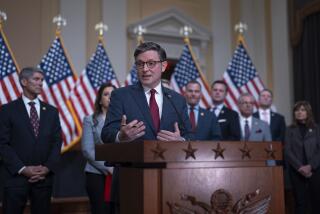Automatic federal spending cuts looking more likely
WASHINGTON — With agreement to lift the nation’s debt ceiling secured, Congress now turns to the next budget showdown: the deep automatic spending cuts due to start hitting the economy in March, which lawmakers appear unwilling — or unable — to stop.
The Senate sent legislation to temporarily suspend the $16.4-trillion debt limit to the White House on Thursday for President Obama’s signature. The vote was 64 to 34, with mostly Republicans and one Democrat opposed.
Now, Congress must decide whether to stop the $1.2 trillion in spending cuts that are scheduled to begin March 1. Those reductions were once considered so severe they would force lawmakers to the table to negotiate a more balanced deficit reduction compromise.
With a month to go, both sides admit there is little hope they can reach agreement.
The cuts, called a sequester in Washington parlance, would slice equally across defense and domestic programs, drawing government spending out of the already sluggish economy.
“I think it’s more likely to happen,” said Sen. Lindsey Graham (R-S.C.), who is leading an increasingly lonely campaign to prevent Pentagon reductions. “In a body that’s known for doing pretty dumb things, this to me wins the prize.”
The prospect of allowing the cuts to take place has divided the Republican Party, as many conservatives have come to the conclusion that severe cuts are better than none, especially as they continue to smart over the tax hikes Obama achieved as part of the year-end “fiscal cliff” deal.
Ever since House Speaker John A. Boehner (R-Ohio) engineered passage of the debt ceiling measure last week in the lower chamber, Republicans on and off Capitol Hill have complained that the party has now lost two opportunities to extract budget cuts from the White House.
“The sequester’s going to go into effect on March 1 unless there are cuts and reforms that get us on a plan to balance a budget over the next 10 years,” Boehner said last week after the House approved the temporary debt ceiling legislation. “It’s as simple as that.”
Boehner devised the bill as a way to punt this most risky of budget issues and move on to others. He wanted to avoid the spectacle of a showdown with the White House that could have led to a default as his conservative troops pressed for spending reductions in exchange for raising the debt limit.
To attract conservative support, the speaker tacked on a provision to withhold lawmakers’ pay if the House or Senate fails to approve a budget for the next fiscal year.
Obama is expected to swiftly sign the measure.
Lawmakers and their aides have acknowledged that while many ideas are being floated to prevent the cuts, the critical differences that have blocked past deals remain: Democrats want tax hikes on the wealthy and corporations; Republicans want only cuts, particularly those that shift the burden from defense and put it on domestic programs.
Some expect the sequestration would go into effect only temporarily, perhaps until March 27, when lawmakers will need to reach agreement to continue funding the government or risk a shutdown.
Senate Majority Leader Harry Reid (D-Nev.) said this week he envisioned a solution that would swap out some spending cuts for modest revenue increases. But that would probably not reach the $1.2-trillion threshold needed to completely offset the scheduled cuts.
Because the amount of the cuts stems from a 2011 agreement to raise the debt ceiling, Republicans say it cannot be decreased. And they insist that all future debt limit increases will require more reductions as part of their commitment to a dollar-per-dollar ratio of cuts to debt.
The measure approved Thursday will suspend the legal limit on the nation’s borrowing authority until May 19, when $450 billion will have been added to the debt, pushing it near $17 trillion.
Congress will again face the prospect of a default if no agreement is reached to allow more borrowing, although the Treasury Department could take measures to pay bills into summer.
More to Read
Sign up for Essential California
The most important California stories and recommendations in your inbox every morning.
You may occasionally receive promotional content from the Los Angeles Times.











